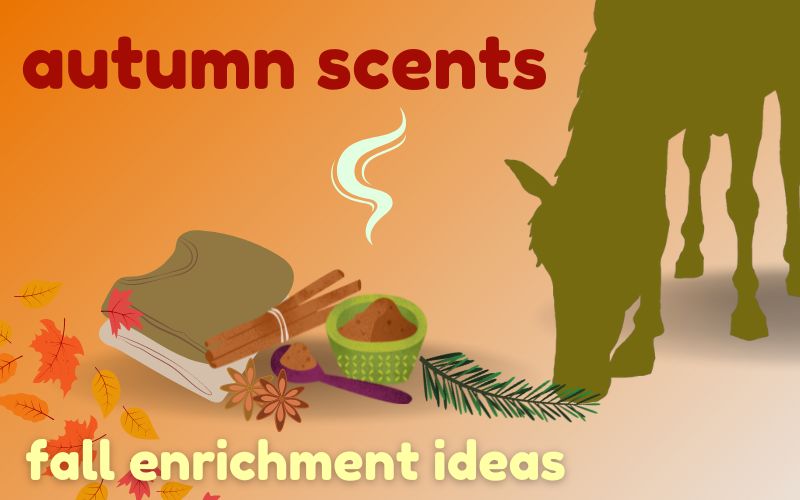
Seasonal themes add interest and variety to your equine enrichment plan. Fall is an especially great time of year for themed activities and enrichment items – and what could be better than the scents that make autumn special? Here are five fall-themed smells to add to your horse’s stall or paddock for special seasonal interest.
Autumn Scents for Horse Enrichment
Scent is one of the easiest yet most meaningful sensory enrichment options for your horse. It’s a lot of fun to theme your sensory enrichment around the seasons – but why is adding scent to your horse’s stall or paddock important?
Sensory enrichment means encouraging your horse to use their senses. Stalls and even most paddocks are sensory-poor environments that don’t provide much stimulation on their own. This means that giving your horse the opportunity to use their senses is a useful way to stave off boredom. The lack of sensory and behavior options in modern stalls and paddocks is one of the reasons all horses really need enrichment.

Scent enrichment is adding smells to your horse’s environment. The best way to offer scent enrichment is with a DIY sensory scent board or other item that keeps the smell confined to a single location. This gives your horse the chance to enjoy the scent or move away from it in the stall or paddock.
If you haven’t read the Beginner’s Guide to Scent Enrichment for Horses, I recommend you start there for more info on scent enrichment. Then come back here for your autumn themed scent inspiration!
Horses don’t need enrichment activities themed around the seasons – a well rounded plan for paddock or stall enrichment will do the trick. But matching your enrichment activities with the time of year is a great way to stay motivated. Plus it lets you take advantage of what each season has to offer.
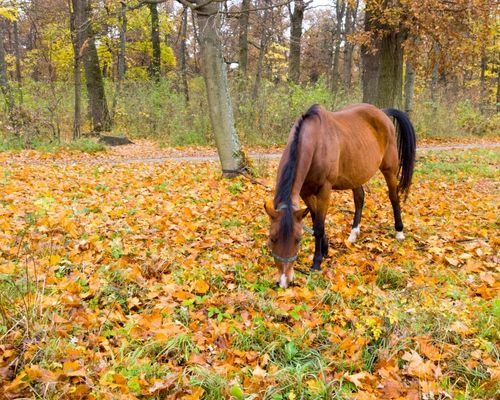
Fall offers lots of opportunities for themed enrichment, including foraging in leaves and straw and other fun outdoor activities. But the smells of autumn might be the best part. Here are five options for fall themed scent enrichment for your equine friend to sniff and enjoy.
Fall Themed Scents #1: Cinnamon

Honestly, naming cinnamon as the first autumn themed scent seems like low-hanging fruit. But is there a scent more instantly associated with the change of seasons from summer to fall? I can’t think of one! And cinnamon is often a favorite scent for horses, too.
Cinnamon is a great enrichment scent because it’s an entirely natural material, harvested from the bark of cinnamon trees.
This means that you can buy cinnamon in minimally-processed form, as well as powdered or liquid versions. And since cinnamon is popular in baked goods – especially in fall – it’s easy to find in any grocery store.
Many, if not most, horses find cinnamon appealing. To use it for enrichment, rub cinnamon bark onto your horse’s scent object, dust with ground cinnamon, or use a drop or two of cinnamon essential oil on a scent board.
One important thing to note about using cinnamon is that it does have a flavor that many horses enjoy. You should only use it on durable items that are clearly not sources of food. You want to avoid any confusion that might encourage your horse to use enrichment roughly or unsafely in an attempt to find a hidden treat.
Fall Themed Scents #2: Pine and Cedar
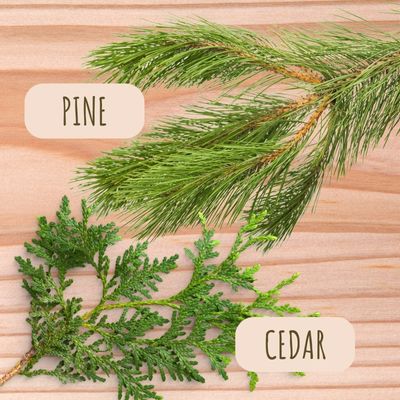
The fresh, woodsy scent of conifer trees is a great addition to your horse’s scent enrichment schedule.
The scent of pine especially reminds me of autumn trail riding trips and perfect, slightly chilly mornings. Like cinnamon, pine and cedar are both naturally sourced and available in a variety of forms.
Unlike cinnamon, pine and cedar are both native to the United States and Europe – meaning that if you like, you can probably source your own fresh conifer material for scent enrichment.
To use pine, collect needles or live, flexible branches and rub them onto your horse’s scent objects. You might want to wear gloves, since fresh pine sap is extremely sticky.
To use cedar, you can screw or nail a simple cedar plank in one corner of your horse’s stall. A bag of cedar shavings hanging just outside the stall for your horse to sniff is another good option. Unlike using cedar shavings as bedding for the whole stall, this won’t create an overwhelming cedar smell for your horse.
Just remember that conifers aren’t edible, so it’s best not to offer whole boughs of either tree. Horses aren’t likely to eat either one because they don’t taste very bad, but a bored horse might be tempted. (A browse board with edible tree branches is a great way to create this experience for your horse.)
If you’re fresh out of live pine trees, pine and cedar are both available as essential oils.
Fall Themed Scents #3: Pumpkin Spice
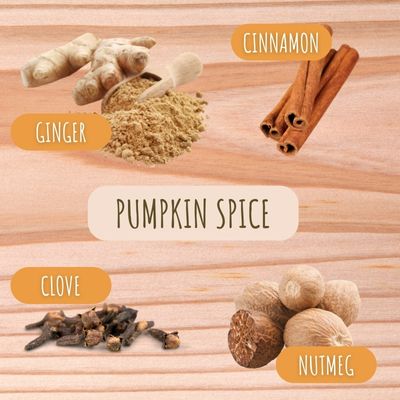
Pumpkin spice is everywhere. I get it. I’m at the eye-roll stage, too.
But your horse can’t read the signs offering pumpkin spice everything as soon as fall hits, so you can give pumpkin spice a try for scent enrichment.
Pumpkin spice is a blend of cinnamon, clove, nutmeg, and ginger. These flavorings are all natural plant products available in the baking aisle of your local grocery. Ginger can also be purchased in whole fresh form in the produce section).
You can also buy pre-ground pumpkin pie spice blend and rub or sprinkle it onto scent objects for your horse to sniff.
Since most pumpkin spice blends are heavy on cinnamon, I like to buy these spices separately and offer them as separate scent enrichments. You can also create your own combinations. This gives you more scent variety than a single bottle of pumpkin spice.
Just remember that, since this smell is so ridiculously popular, it’s easy to find synthetic versions of the scent in sprays, wax diffusers, and other products. I prefer to keep things natural with scent enrichment, since we don’t know how horses perceive artificial scents and flavors.
Fall Themed Scents #4: Campfire Smoke
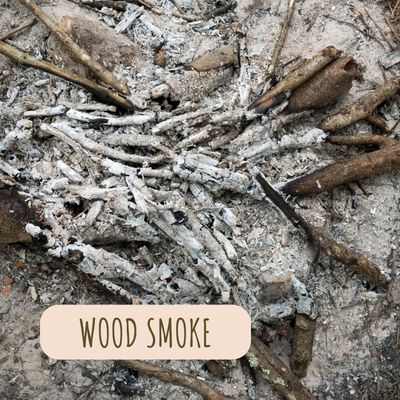
Fall is campfire season – and campfires burning natural wood have a unique scent that just seems to smell wonderful to human beings.
The scent of a campfire or fireplace is a creative option for horse enrichment, but it’s one that requires more thought and care. The scent of smoke or wood ashes may offer extra interest for some horses, so campfire scent made the list for an unusual fall-themed scent option.
With that said, this scent choice may not be a favorite – it’s a “your mileage will vary” scent. After all, your horse’s wild ancestors needed to avoid dangerous wildfires, and some horses may find the smell worrying.
At minimum, smelling burned wood and smoke up close is a new experience for many horses, and can trigger caution or nervousness due to novelty. As with all enrichment experiences, it’s important to observe your horse and see how they respond. If they seem uncomfortable, try the smell again later and don’t leave your horse confined in a stall with the campfire smell.
Real fires and stables obviously don’t mix. If you want to try this interesting scent option, the easiest way is to head back to the grocery store (you’ve already gotten pumpkin spice so why not?) and pick up a bottle of liquid smoke. You can also find it on Amazon if you prefer online ordering. Add a single drop or two to your horse’s scent objects and see how they respond.
If you’ve recently had a campfire with friends or family, or brush has been burned around the stable, you can also scoop up a little of the ash and charred coals. Place this in a corner of the stall floor for sniffing or use an outside-the-stall sachet. Rubbing it on your scent board will permanently stain it black!
Setting up the remains of a campfire for sniffing is a great addition to a fall sensory walk with your horse, too.
Fall Themed Scents #5: Wool

An unusual but interesting fall themed scent for horse enrichment, wool is the smell of sweaters and woven blankets pulled from storage when the autumn chill hits.
But horses don’t wear sweaters – so why include the smell of wool in your scent enrichment rotation?
Horses don’t drink pumpkin spice lattes either, so no worries there. The value of scent enrichment is to offer variety and stimulation through a rich and varied array of smells. We know that today’s equestrian can’t exactly replicate the smells of a wild environment.
But wool offers the distinct perk of being a real, natural animal smell. It lets your horse have the experience of detecting another species of animal and getting information from the scent.
So, surprisingly, the smell of fall sweaters is actually a hidden enrichment power player – giving your horse sensory and social enrichment, all in one.
To use the smell of wool, I recommend sourcing some wool that’s still, well, sheepy. Processing wool to make clothes removes most of its scent.
If you’re lucky, you can source real wool from a local farmer, buying offcuts of raw wool that would otherwise be discarded. Raw wool is also available online. To use it, place the wool in the corner of the stall or inside a simple hanging container outside the stall bars.
A good alternative to fresh wool is minimally processed lanolin. This is the oil pressed from wool during processing, and you can buy it in the skincare section of any large retailer or online. Do note that lanolin is an animal product – for ethical reasons, I recommend buying from small-scale suppliers.
Where Are the Apples and Pumpkins?!
If you immediately think of pumpkins and apples when it comes to fall, you might be wondering why they didn’t make the list of fall-themed horse enrichment scents.
It’s because both of these are food products and I regularly include them in treat puzzles and other food enrichment for horses!
Apples are a favorite treat food for many horses, and pumpkin is a great low-sugar option that many horses love to eat – it even has a whole article on five awesome ways to use pumpkin as horse enrichment.
But this means that your horse probably associates both these smells with edible things.

Your horse uses their sense of smell to find food, so using edible scents on your inedible sensory objects can be confusing to your horse. If they believe the item might contain hidden food, they could rough up the item in an attempt to access the (non-existent) treats.
Smelling food but being unable to get it can also trigger frustration, which isn’t the goal of horse enrichment!
For those reasons, I didn’t include either apple or pumpkin on this list. Also, as mentioned above, if you regularly use cinnamon as a diet supplement or flavor additive, you’ll want to use extra caution as well.
Related Enrichment
Sensory enrichment is an amazing way to add extra novelty and stimulation to your horse’s environment. For more sensory ideas, try:
The Beginner’s Guide to Scent Enrichment for Horses